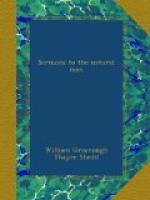“I am a nobler substance than the
stars,
Or are they better since they are bigger?
I have a will and faculties of choice,
To do or not to do; and reason why
I do or not do this: the stars have
none.
They know not why they shine, more than
this taper,
Nor how they, work, nor what."[2]
But this characteristic of a rational being, though thus distinctive and common to every man that lives, is exceedingly marvellous. Like the air we breathe, like the light we see, it involves a mystery that no man has ever solved. Self-consciousness has been the problem and the thorn of the philosophic mind in all ages; and the mystery is not yet unravelled. Is not that a wonderful process by which a man knows, not some other thing but, himself? Is not that a strange act by which he, for a time, duplicates his own unity, and sets himself to look at himself? All other acts of consciousness are comparatively plain and explicable. When we look at an object other than ourselves,—when we behold a tree or the sky,—the act of knowledge is much more simple and easy to be explained. For then there is something outside of us, and in front of us, and another thing than we are, at which we look, and which we behold. But in this act of self-inspection there is no second thing, external, and extant to us, which we contemplate. That which is seen is one and the same identical object with that which sees. The act of knowledge which in all other instances requires the existence of two things,—a thing to be known and a thing to know,—in this instance is performed with only one. It is the individual soul that sees, and it is that very same individual soul that is seen. It is the individual man that knows, and it is that very identical man that is known. The eyeball looks at the eyeball.




